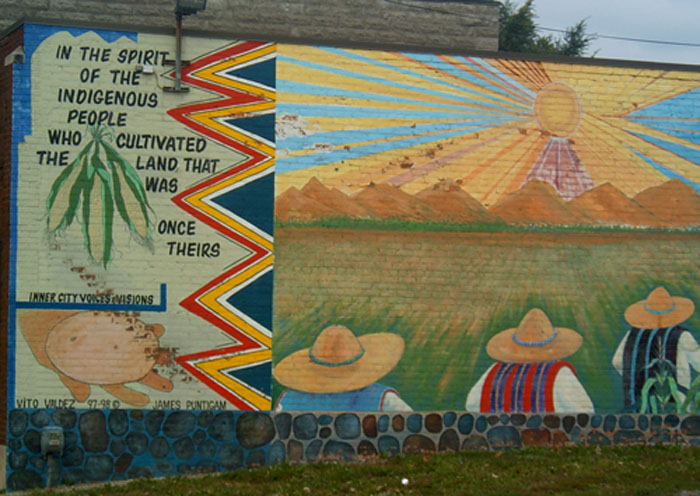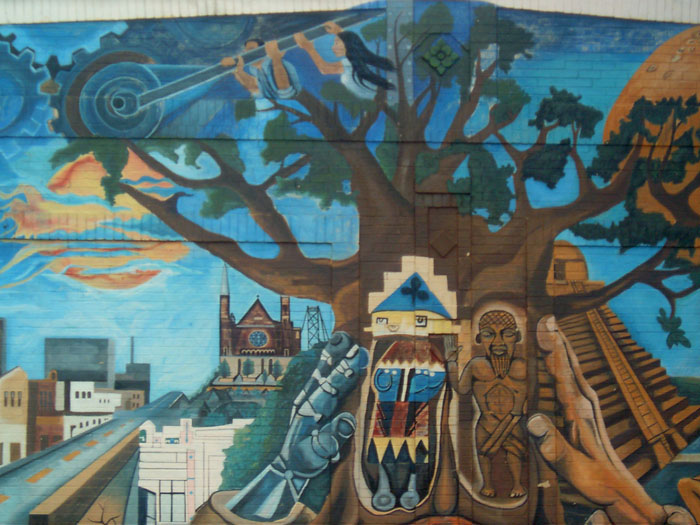

The Indigenous Philosophy in "El Plan Espiritual de Aztlán"
The Chicano Movement came to address some of the main issues of Civil Rights and social politics that generations had failed to address. By accepting the concept of Aztlán, Chicanos were rejecting the negative connotations that they and society had associated with the matzo-Indian aesthetic for so long.1 In a way, Chicanos were proclaiming pride in their indigenous roots; they were accepting their background and that of their parents. As Chicanos were articulating ”their identities and histories as Chicanos both to themselves and to society at large," 2 they developed influential plans that contributed to the advancement of the movement.
El Plan Espritual de Aztlan was issued in March 1969 in Denver, Colorado at the first Chicano Youth Liberation Conference.3 The plan reinforced the cultural nationalism that underlayed the movement.4 It served to address the ties, both moral and historical, between the Chicano struggle and Mexican people. The term Aztlan refers to the Aztec myth of a homeland somewhere to the north of present-day Mexico City.5 Aztlán provided a place where Chicanos could one day return both empowered and free of the oppression and discrimination that they were facing and had been facing for decades. For the students of the movement, Aztlán symbolized a legendary and heroic Aztec past; the Aztec people were deemed warriors and were therefore strong and powerful. They believed that only a return to Aztlán would guarantee both economic and political control and autonomy of their communities.6
The language constituting the plan itself reveals the cultural nationalism expressed by the Chicanos during the movement. The following are some of the passages from El Plan Espiritual de Aztlan that demonstrate their cultural nationalism:
The plan refers to Chicanos as “inhabitants and civilizers of the northern land of Aztlán from whence came our forefathers.” This exemplifies how Chicanos accepted their indigenous roots, which had once been negated by white society. This pride can also be seen in the declaration that the “call of our blood is our power, our responsibility, and our inevitable destiny.”
“Aztlán belongs to those who plant the seed, water the fields, and gather the crops and not to the foreign Europeans. We do not recognize capricious frontiers on the bronze continent.” Here the plan addresses the actual land that is considered to be Aztlán, the Southwest territory of the United States that was acquired at the signing of the Treaty of Guadalupe Hidalgo.7 The students believed that although the United States possessed the land and state boundaries were set, this land, which contained Aztlán, belonged to the many people who cultivated it and who had previously posssed it.
“With our heart in our hands and our hands in the soil, we declare the independence of our mestizo nation. We are a bronze people with a bronze culture…we are a nation, we are union of free pueblos, we are Aztlán.” This statement calls for ethnic unity among Mexicans, whether immigrant or native-born. It is defining all “Mexican-origin people in the United States as La Raza Bronze (the Bronze People).”8 It was extremely important that Chicanos unite themselves with their culture. In declaring “the independence of our mestizo nation” the students sought to recover self-identity and freedom from the oppression that they as a people had suffered for years. By declaring that Chicanos are a “bronze people with a bronze culture,” the students were proclaiming their culture by refusing the government’s classification as “white,”9 and Aztlán represented that unifying force of “nonmaterial heritage."10 A “somatic manifestation of ‘indianness’ becomes the marker of one’s identity;”11 therefore, the students, in order to establish self-identity, utilized the phrase “bronze people” to distinguish Chicanos.
“Nationalism as the key to organization transcends all religious, political, class, and economic factions or boundaries. Nationalism is the common denominator that all members of La Raza can agree upon.” This statement exemplifies, once again, the will of the students to access their political, economic, and social discrimination through nationalism.


Left: Located in South west Detroit, this mural demonstrates the respect amongst Latino farmworkers; it also exemplifies El Plan Espiritual de Aztlán's statement about the land belonging to those who cultivate it.
Right: This mural also from Detroit, represents the indigenous roots of Chicanos.